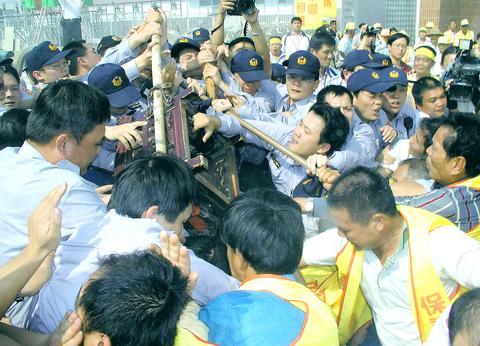A series of protests against waste incinerators across Taiwan yesterday highlights the contentiousness of the Environmental Protection Administration's (EPA) policy review relating to waste management .
In the south of Kaohsiung County, more than 200 residents of Taliao Township protested yesterday morning against a medical waste incinerator in the Tafa industrial complex, where an average of 90 tonnes of medical waste, collected from 82 hospitals and 2,182 clinics, is burnt every month.
The egg-throwing demonstrators said they often smelt a foul odor because the incinerator spewed out excessive pollutants.

PHOTO: WU JEN-CHIEN, TAIPEI TIMES
They said the dioxin concentration tested earlier this month was much higher than the limit stipulated in new regulations to apply from next year.
"The concentration of dioxin is 203 times the acceptable level. So does the government think our lives are worthless?" Taliao township chief Huang Tien-huang (
The protesters later appealed to Kaohsiung County Commissioner Yang Chiu-hsing (
Yang said however that the operators of the incinerator would be punished if they failed to meet the standards by next year.
According to the incinerator's operators, the plant has been closed since Tuesday for renovations.
Meanwhile, in Taichung County, more than 300 residents of Wujih Township protested against a newly-completed NT$4.5 billion incinerator.
Carrying a deity, demonstrators tried to forcibly enter the plant but were stopped by police.
Unlike Kaohsiung, the Wujih protesters said they would accept the incinerator as long as they were suitably compensated.
Environmental officials from the Taichung County government said NT$19 million would be allocated to local construction projects.
They said the incinerator was being tested and would not be officially launched until early next year.
The demonstrations were augmented by protests in front of the EPA in Taipei yesterday afternoon. Dozens of activists from environmental groups took part, saying that unsettled disputes over incinerators required an immediate change of policy.
Citing the example of an incinerator under construction in Miaoli County's Chunan Township, activists said the government should first improve the current recycling rate of 3 percent rather than rely on incineration.
"We don't want a cent from the government and we will hold a referendum next month to express our strong opposition," said Hsu Ming-sung (許明松), an anti-incinerator activist from Miaoli.
Representatives of Chichi Township in Nantou County said that the result of their referendum clearly expressed their opposition against the incinerator project.
The result was sent to related agencies, including the Cabinet, the EPA, the Nantou County Government and the township office.
"If our opinions can't be taken seriously even now, then we might file a lawsuit against the government based on environmental laws," said Tsai Yuan-chou (
Demonstrators had presented a petition asking new EPA chief Chang Juu-en (
"In this report, the EPA is still sticking with using incinerators. So what else is new?" said Hsieh Herlin (
EPA officials said the analysis recommended several policy adjustments, after taking into account earlier criticism from several sources, including residents, legislators and environmentalists.

US climber Alex Honnold is to attempt to scale Taipei 101 without a rope and harness in a live Netflix special on Jan. 24, the streaming platform announced on Wednesday. Accounting for the time difference, the two-hour broadcast of Honnold’s climb, called Skyscraper Live, is to air on Jan. 23 in the US, Netflix said in a statement. Honnold, 40, was the first person ever to free solo climb the 900m El Capitan rock formation in Yosemite National Park — a feat that was recorded and later made into the 2018 documentary film Free Solo. Netflix previewed Skyscraper Live in October, after videos

Starting on Jan. 1, YouBike riders must have insurance to use the service, and a six-month trial of NT$5 coupons under certain conditions would be implemented to balance bike shortages, a joint statement from transportation departments across Taipei, New Taipei City and Taoyuan announced yesterday. The rental bike system operator said that coupons would be offered to riders to rent bikes from full stations, for riders who take out an electric-assisted bike from a full station, and for riders who return a bike to an empty station. All riders with YouBike accounts are automatically eligible for the program, and each membership account

NUMBERS IMBALANCE: More than 4 million Taiwanese have visited China this year, while only about half a million Chinese have visited here Beijing has yet to respond to Taiwan’s requests for negotiation over matters related to the recovery of cross-strait tourism, the Tourism Administration said yesterday. Taiwan’s tourism authority issued the statement after Chinese-language daily the China Times reported yesterday that the government’s policy of banning group tours to China does not stop Taiwanese from visiting the country. As of October, more than 4.2 million had traveled to China this year, exceeding last year. Beijing estimated the number of Taiwanese tourists in China could reach 4.5 million this year. By contrast, only 500,000 Chinese tourists are expected in Taiwan, the report said. The report

Temperatures are forecast to drop steadily as a continental cold air mass moves across Taiwan, with some areas also likely to see heavy rainfall, the Central Weather Administration (CWA) said. From today through early tomorrow, a cold air mass would keep temperatures low across central and northern Taiwan, and the eastern half of Taiwan proper, with isolated brief showers forecast along Keelung’s north coast, Taipei and New Taipei City’s mountainous areas and eastern Taiwan, it said. Lows of 11°C to 15°C are forecast in central and northern Taiwan, Yilan County, and the outlying Kinmen and Lienchiang (Matsu) counties, and 14°C to 17°C